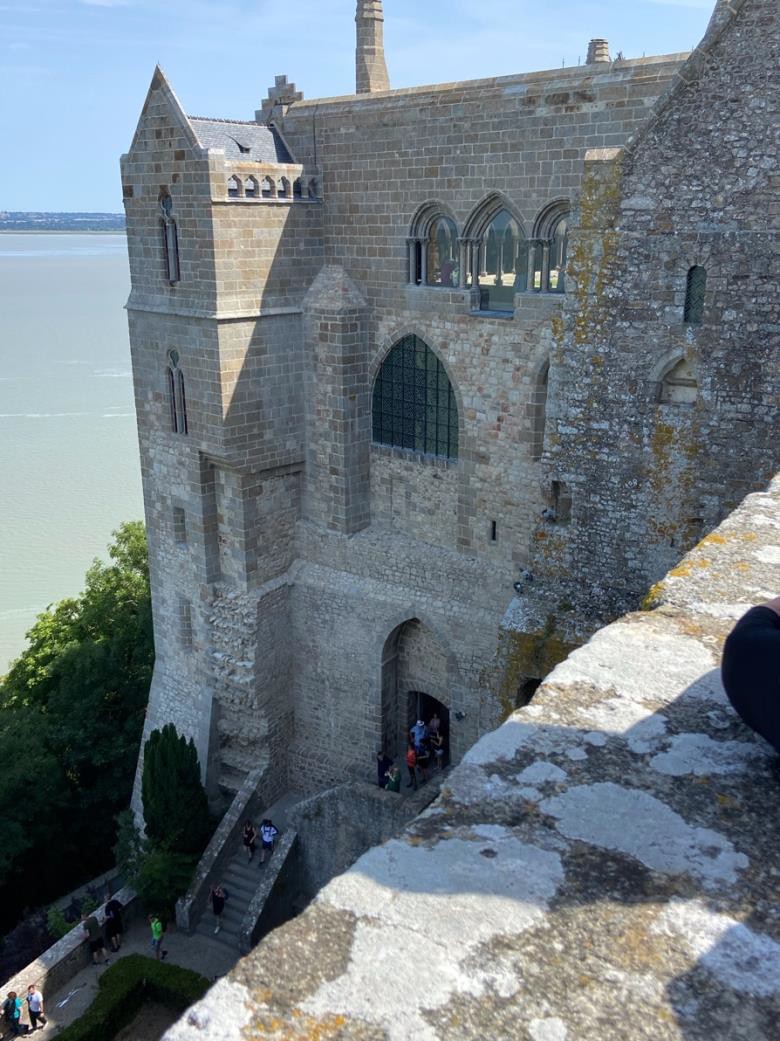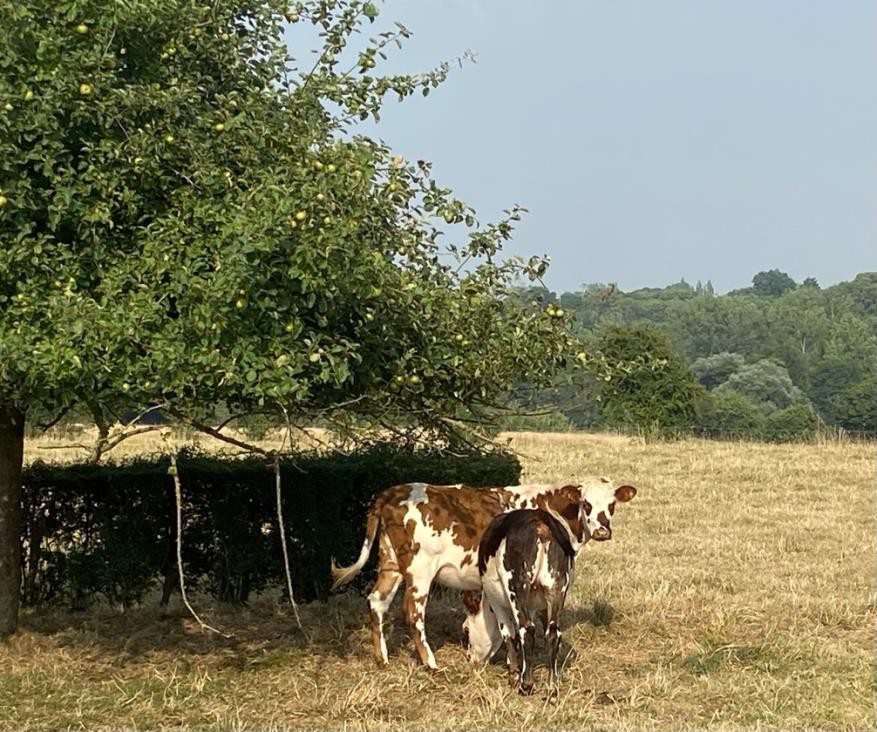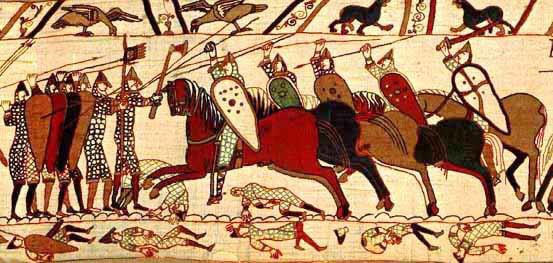The weather has turned. There’s a bit of rain and cooler temperatures. This morning, before heading to our next destination, I was able to take a walk through the countryside. The cloud cover softened the landscape. The wheat fields and rolling hills were framed by breaks in the hedge rows. Our stay in Normandy was restorative and informative. The hotel, Château Saint Gilles, located two miles outside of Bayeaux, was serene. The grounds included a small orchard, a vegetable garden, pool, and nature trail. The best meals of the trip were consumed at the Saint Gilles.


For the cooks in my circle, the chef prepared risotto, but instead of using cream or milk, he prepared it with a « green juice ». The risotto was still rich but delightfully light, suitable for a warm summer night. The green juice was an emulsion of celery, parsley and cucumber. It was delicious. The dish above is from the barbecue the following night.


I wish the Château was closer to Boulder, it is a restful respite.
Le Mont St. Michel
Mont St. Michelle was on my list of « must see places ». The abbey, built in the 8th century was, according to legend, due to the intercession of St. Michael. St. Michael appeared twice in dreams to the local bishop and instructed him to built a church. The bishop ignored the request. The third time, the archangel pressed his finger on the forehead of the bishop. When the bishop awoke, he saw the mark of the archangel and began the construction. The skull of the bishop is on display in a Normandy church and there is a visible indentation and small hole in the center of the forehead.
The construction is remarkable, especially considering the location and equipment available in the 700’s. The abbey underwent changes. Fortifications were added, along with dormitories for the guards and rooms for their weapons. Areas for noble visitors were also built.
The tides surrounding the isle can be in excess of 48’. This made the approach a bit treacherous. During the Middle Ages, pilgrims from throughout Europe would travel to the abbey. The final leg of their journey, the ascent to the abbey, would be made on their knees!

During the French Revolution, the abbey was converted into a prison. There are several oubliettes. The word « oublier » in French means to forget. The rooms were effectively dark, dank solitary cells, were prisoners, condemned to a life sentence, would be jailed.
By the 1830’s, several French citizens, including Victor Hugo, mounted a campaign to restore and save « this marvel of French history ».
They were very successful. Today, Mont St. Michel is a UNESCO site. However, that protected status brings notoriety and tourists. The paths are narrow and the access through the small town at the base is jammed with tourists, shops and over priced cafes.


The crowds and the ascent on steep stairs can dampen the mood. However, I was quite fortunate. We toured the abbey on Sunday and arrived at the chapel during Mass. The priest had a beautiful voice. Incense hung in the air, but it wasn’t the incense of my youth, cloying and intense. It was ethereal. Light streamed in through the stained glass windows and I felt at peace and joyful. The experience was unexpected and perhaps that’s why people travel, for those glorious, unplanned moments.
D-Day, beaches and sites
The next day, despite the very warm weather, we toured WWII sites. The tour was nicely bookended as our first stop was the German Cemetery and our last stop was the Normandy American cemetery.
The German cemetery was initially an internment site for American GIs. 70% of the Americans killed in the European theater had their remains returned to the States. The French did not want to give any soil to the Germans, so the Americans deeded their plot of land to Germany. Over 22,000 German troops are buried here, two soldiers to each grave. The cemetery is somber and has a melancholy air. The markers are made of basalt lava.

The Third Reich believed many areas of Europe were inherently German. In France this included several towns in northern and eastern France. French citizens were conscripted into the Wehrmacht.
A sign at the entrance to the cemetery reads:
Until 1947, this was an American cemetery. The remains were exhumed and shipped to the United States. It has been German since 1948, and contains over 21,000 graves. With its melancholy rigour, it is a graveyard for soldiers not all of whom had chosen either the cause or the fight. They too have found rest in our soil of France.
Our next stop was St. Mère Église, a village made famous in the movie, The Longest Day. There’s an excellent museum dedicated to the American paratroopers. As a quick reminder, a home in the village had caught fire shortly before midnight. The town was a buzz with activity and the German soldiers were awake and on alert. The blaze was mistaken as a signal fire. Nearly half of the American paratroopers were killed before touching French soil.. It was a tragic and could have been seen as a very bad omen for the invasion. The church has a paratrooper dangling from the roof top on permanent display.

From there, we traveled to Utah beach and Pointe du Hoc.
 In Reagan’s speech (1984) at Normandy, the gallantry of the Rangers who ascended and secured Pointe du Hoc is referenced. I’ve watched movies and newsreels of the landings, however, I was in awe after seeing the area and standing on the cliff. The landing at Pointe du Hoc, was also beset with problems, yet the Rangers adjusted, endured and fought.
In Reagan’s speech (1984) at Normandy, the gallantry of the Rangers who ascended and secured Pointe du Hoc is referenced. I’ve watched movies and newsreels of the landings, however, I was in awe after seeing the area and standing on the cliff. The landing at Pointe du Hoc, was also beset with problems, yet the Rangers adjusted, endured and fought.

Omaha Beach, less a nice memorial in the center, is a popular spot for sun bathing and splashing in the waves. I was happy to see children and families enjoying the beautiful warm sunny day. It’s the reason so many fought and died. The area has been developed with homes on the hillsides and a busy main road between the beach and the hillside.
The terrain would have been challenging on June
6th, even if everything had gone right. Nearly everything went wrong on June 6th. The bombardment, meant to take out the guns and demoralize the troops, missed the target. Thus the Germans were alert and at their stations for the first landing of the engineers. The engineers would have worked to clear paths through the obstacles, but they had a high fatality rate. So the second wave to come ashore had no clear path and encountered relentless fire. 4 hours after the first wave, a destroyer fired on the hillside.
The cemetery at Normandy is located near Omaha Beach. It is grand and solemn. The blue waters of the channel are visible from most spots in the cemetery. People from many countries tour the grounds.
Brigadier General Theodore Roosevelt is buried here. He died of a heart attack shortly after landing with his troops on Utah Beach. There is one soldier from WWI buried in The American Cemetery, Quentin Roosevelt. The Army will bury brothers next to each other. Since Theodore was a General, Quentin, an aviator and xxx, at the time of his death, was reinterred.

Normandy – life and food
Aurélie helped us explore Normandy. It’s impossible to live in this region unless you have access to a car. The area is vast and has almost no bus transport. The train is handy, but only if you live along the route. We traveled an hour from Bayeux to get to most points of interest.
Our first stop was a charming village, Beauvron-En-Auge. It has the distinction of being one of the most beautiful villages in France. There are less than 100 villages with this designation. A village must apply for the honor. There are many criteria and there are many inspections to confirm that the village meets or exceeds all the criteria.
The award is prestigious and economical helpful. Many tourists visit one or several of the « Le Plus Beaux Villages de France » when vacationing.


Our next stop was a Calvados distillery. The small orchard, less than 40 acres, has been managed by the same family for five generations. Calvados uses apples in the distillation process. Similar to Cognac, it is aged and has a high alcohol content. I found the less intense version, Pommeau, more palatable. Since Pommeau is used in many local delicacies, I’m bringing back a bottle and a page of recipes.

Lunch was at a local crêperie. In Normandy, even though the restaurant is called a Crêperie, you will order a galette. The local crepe/galette is made with buckwheat. Andrea had the regional specialty, ham, Emmental and mushrooms. The combination was perfect.
After lunch, we stopped by a small farm that produces Camembert. The owners are committed to sustainable, organic farming. The solar panels power the refrigeration and the milking machines. They have 12 cows that are milked once each day. The Normandy cows have a distinctive face. The French refer to the cow as having glasses due to the rings around the eyes.


We sampled the Camembert with poire, a cider made with pears. It was delicious. Our host was very gracious and quite proud of her enterprise.
My last stop of the day was back in Bayeux at the Tapestry Museum. The museum has the 220’ Bayeaux tapestry displayed in a dimly lit, climate controlled environment. Though it’s called a tapestry, the work is one of embroidery, meant to document and propagandize William’s victory at Hasting in 1066.
There is much still disputed about the tapestry. Originally, it was thought to be sponsored by Mathilde, the wife of William, and fabricated in England. I side with the scholars who believe the Bishop of Bayeaux, Odo, commissioned the work as he is featured prominently in several frames of the work. Odo was also the maternal half brother of William the Conqueror.

In one frame, the Bishop is seen riding into battle. He is carrying a mace. At the time, the clergy would never brandish a sword which could harm a man, but it was totally ok to use a mace and knock either a rider or horse senseless.

There are also frames of the tapestry with Mont Saint Michel in the background. One where Harold is shown rescuing two men from the quicksand around the island. In another scene, the abbey is seen in the background has William’s troops prepare for battle.

The tapestry was displayed at the Cathedral of Bayeaux. It is remarkable that the tapestry survived the last 1,000 years. There were two fires in the cathedral, but the tapestry survived both. One time, the work was used as a tarpaulin to cover weapons that were being secreted out of the city during the French Revolution. In 1794, the tapestry was to be cut up to decorate a float for the Festival of Reason. Fortunately, the local Committee of the Arts stepped in to preserve the work.

Bayeaux, in particular, and Normandy in general, is a wonderful destination. If you don’t mind driving a car in a foreign country, where the roads can be quite narrow, where round-abouts are prevalent and where a two lane row is barely one lane, take the risk and explore the area.
Next up – Strasbourg